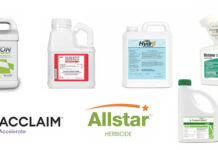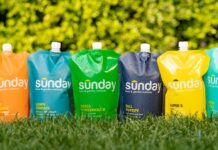Summer weed control can be a challenge, not because of the volume of weeds, but because of the diversity of species present in the turf. They may include perennial broadleaf weeds that escaped or recovered from a springtime herbicide application, as well as grassy weeds and sedges that may need to be treated.
Although fall is the best time to control perennial weeds, such as dandelion, the plantains and white clover, spring and early summer (depending on the weed) is the time to target annual broadleaf weeds.
There have been many changes and additions to the list of broadleaf herbicides for use in turfgrass since the year 2000. Some newer herbicides include Pylex and the combination product Last Call.
Many of these combination products are more expensive compared to standard three-way formulations such as 2,4-D, MCPP and dicamba. However, the products in the table included with this article are good choices for summer spot treatments in cases where, in addition to broadleaf weeds, crabgrass or yellow nutsedge are also present.

If yellow nutsedge is present, choose a combination product that contains sulfentrazone. If you have crabgrass, a product that contains quinclorac, mesotrione, topramazone or fenoxaprop will provide control. Alternatively, you can tank mix a nutsedge herbicide, such as sulfentrazone or halosulfuron, or a crabgrass herbicide, such as quinclorac, with your favorite three-way broadleaf herbicide product.
One note of caution about the control of crabgrass: pay attention to the stage of crabgrass growth when the application is made. Crabgrass is much easier to control when it is still in leaf stage, before tillering. After it begins to tiller, control can be difficult. Herbicides are very effective on leaf stage crabgrass. However, control of actively growing and flowering two- to five-tiller crabgrass can be a challenge.
In our testing (The Ohio State University turf research plots) we have seen instances where after a mixed stand of dandelion, clover and crabgrass was treated with a combination herbicide the broadleaf weeds were eliminated; however, the actively tillering crabgrass was only stunted, and upon recovery, filled in the areas that used to be occupied by the broadleaf weeds. This can be avoided by making applications when crabgrass is in leaf stage, or depending on the herbicide, waiting a week or two until after the crabgrass has reached maturity.
If you can’t make the application to leaf stage or one-tiller crabgrass, then it may be better to wait a couple of weeks because mature crabgrass is more susceptible to herbicides such as quinclorac than it is when tillering.

Tough customers to treat
Some annual broadleaf weeds can actually be quite difficult to control, especially if they are mature and hardened off due to summer heat and drought stress. You may get better control of annual broadleaf weeds by using a product that contains carfentrazone, sulfentrazone or pyraflufen-ethyl. This is especially true if you treat them when they are just emerging.
Since they are annual plants, control is also possible with the use of a preemergence herbicide.
Remember, most annual broadleaf weeds are not competitive with a dense, healthy stand of turfgrass.
Summer temperatures increase the chance of non-target injury to surrounding trees and ornamentals when using postemergence materials. The best control of weeds in cooler weather is with ester formulations of the phenoxy and pyridinoxy herbicides. However, as temperatures rise into the 60s and 70s, the ester formulations become very volatile, and non-target injury can occur. Amine formulations will reduce this risk in warmer weather.
Regardless of formulation, when air temperatures exceed 80 to 85 degrees Fahrenheit, postemergence broadleaf herbicides can cause phytotoxicity to the turf and should not be applied. Applications in this case are most advisable in the early morning hours.
Summer weed control can be a challenge, not because of the volume of weeds, but because of the diversity of species present in the turf.

Newer herbicides
Last Call herbicide is a new combination herbicide from NuFarm that contains the active ingredients dicamba, fluroxypyr and fenoxaprop. Because it contains fenoxaprop it has activity not only on broadleaf weeds, but also on crabgrass.
Fenoxaprop is typically thought to be more active on leaf stage crabgrass than on tillering crabgrass. However, our research suggests that Last Call can be effective against crabgrass that is in the one- to two-, or even two- to four-tiller stage at application.
It is labeled for golf fairways and roughs, residential and commercial turf and sports fields and is safe on Kentucky bluegrass, perennial ryegrass, tall fescue, fine fescue and zoysiagrass. Last Call is also labeled for selective removal of bermudagrass. Consult the label for specifics.

Change Up herbicide is another new combination herbicide from NuFarm. Change Up contains the active ingredients MCPA, fluroxypyr and dicamba. Control of broadleaf weeds is very good with this formulation and this is a good product to consider in areas that are sensitive to the use of 2,4-D.
Pylex herbicide is a recent introduction from BASF containing the new active ingredient topramazone, which has a similar mode of action to that of mesotrione, the active ingredient in Tenacity herbicide. Topramazone inhibits carotenoid biosynthesis which results in bleaching of affected leaf tissues.
Pylex is only for use on centipedegrass or the cool-season turfgrasses Kentucky bluegrass, perennial ryegrass and tall or fine fescue. Please note that as of this writing, Pylex is labeled only for spot-treatment applications on sports turf and residential surfaces and there is a special section on the label that articulates this. It is possible though that in the near future the spot application restriction will be lifted and broadcast applications will be permitted.
Topramazone has both preemergence and postemergence activity and Pylex is labeled for the control of 15 grassy and 39 broadleaf weeds, both annual and perennial. It is excellent for the control of goosegrass and sedges. In addition, research has found that it can be very effective for the postemergence control of tillering crabgrass.

In trials at The Ohio State University, we found that control was similar, or in some cases, better than control of crabgrass with mesotrione or quinclorac.
Pylex also has activity on perennial grassy weeds and is labeled for either suppression or control of creeping bentgrass, bermudagrass, dallisgrass and nimblewill. Control of these weeds is achieved with a three-application schedule similar to that of mesotrione. Consult the label for specifics.
For broadleaf weed control, research at The Ohio State University has found that topramazone has good activity against white clover but is not as active against broadleaf weeds such as dandelion or ground ivy. Pylex (similar to mesotrione) can be applied on the day of seeding for suppression or control of germinating grassy and broadleaf weeds but is safe to seedlings of tolerant turfgrass species.

Defendor is a newer herbicide from Dow AgroSciences that contains the active ingredient florasulam. It is currently available in a co-pack with Dimension 2EW. Defendor herbicide is not intended for use during the summer months, but rather Dimension and Defendor should be applied together in the spring and this can either be with one application or with split applications about eight weeks apart.
Florasulam works well in cooler temperatures. It has a very low use rate compared to most other herbicides used in turfgrass. Defendor can be used safely on all major turfgrasses and should be applied at typical preemergence crabgrass timing. To prevent dandelion flowering, application should be made prior to dandelion bloom.

Weeds controlled include dandelion, white clover, common and mouse-ear chickweed, mustard and shepherd’s purse. Because it is meant to go out with Dimension, the application is made considerably earlier than other broadleaf herbicides. However, florasulam results in very long-lasting control.
Research conducted at The Ohio State University shows that a single application of Defendor herbicide will give more than 90 percent control of both dandelion and white clover for 84 days. On plots receiving sequential applications control was still nearly 100 percent at 98 days after the initial application. An application on March 31 resulted in a 100 percent decrease in dandelion bloom. This product may be an excellent choice in areas that are sensitive to the application of 2,4-D.
David Gardner, Ph.D., is with the Department of Horticulture & Crop Sciences at The Ohio State University and is also an editorial advisor for Turf magazine.











![[VIDEO] Dickies®: Discover Workwear That’s Anything But Uniform](https://turfmagazine.com/wp-content/uploads/2023/06/1647663814-4b1a2a7742790a9b1e97a3b963477850192e1d6a9dfba9b07214a77bae25d6e3-d-218x150.jpg)






























![[VIDEO] Dickies®: Discover Workwear That’s Anything But Uniform](https://turfmagazine.com/wp-content/uploads/2023/06/1647663814-4b1a2a7742790a9b1e97a3b963477850192e1d6a9dfba9b07214a77bae25d6e3-d-324x160.jpg)